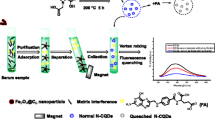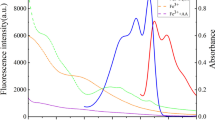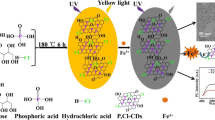Abstract
In this paper, nitrogen-doped carbon dots (N-CDs) with a quantum yield of 23.6 % were successfully synthesized by microwave pyrolysis of urea using diethylene glycol as the high boiling point reaction medium. The N-CDs were spherical and monodisperse with a size distribution between 1.5 and 5.5 nm. The N-CDs exhibited excellent water-soluble property and remarkable stability under extreme ionic strengths and light illumination. The fluorescence of the N-CDs could be quenched by Fe3+ through the static quenching mechanism, but not by other common metal ions. On this basis, the N-CDs can be used as a facile sensing platform for label-free sensitive and selective detection of Fe3+ in a linear range of 1.6–333.3 μmol L−1, and the detection limit was 0.45 μmol L−1 obtained at a signal-to-noise ratio of 3. Importantly, the N-CDs-based fluorescent probe was successfully applied to the direct analysis of iron contents in human serum samples, which demonstrated potential applications in biological and clinical analysis.








Similar content being viewed by others
References
Altamura S, Muckenthaler MU (2009) Iron toxicity in diseases of aging: Alzheimer’s disease, Parkinson’s disease and atherosclerosis. J Alzheimers Dis 16:879–895
Annie Ho J, Chang HC, Su WT (2012) DOPA-mediated reduction allows the facile synthesis of fluorescent gold nanoclusters for use as sensing probes for ferric ions. Anal Chem 84:3246–3253
Busto MEDC, Montes-Bayón M, Bettmer J, Sanz-Medel A (2008) Stable isotope labelling and FPLC–ICP-SFMS for the accurate determination of clinical iron status parameters in human serum. Analyst 133:379–384
Chen Z, Lu D, Zhang G, Yang J, Dong C, Shuang S (2014) Glutathione capped silver nanoclusters-based fluorescent probe for highly sensitive detection of Fe3+. Sens Actuators B 202:631–637
Crichton RR, Ward RJ (1992) Iron metabolism-new perspectives in view. Biochemistry 31:11255–11264
Fassett J, Powell L, Moore L (1984) Determination of iron in serum and water by resonance ionization isotope dilution mass spectrometry. Anal Chem 56:2228–2233
Gong X et al (2015) Facile synthesis of nitrogen-doped carbon dots for Fe3+ sensing and cellular imaging. Anal Chim Acta 861:74–84
Huang H, Lv J-J, Zhou D-L, Bao N, Xu Y, Wang A-J, Feng J-J (2013) One-pot green synthesis of nitrogen-doped carbon nanoparticles as fluorescent probes for mercury ions. RSC Adv 3:21691–21696
Jafarian-Dehkordi A, Saghaie L, Movahedi N (2008) A new spectrophotometric method for direct determination of iron (III) in serum. DARU J Pharm Sci 16:76–82
Jia F, Yao Z, Jiang Z, Li C (2011) Preparation of carbon coated TiO2 nanotubes film and its catalytic application for H2 generation. Catal Commun 12:497–501
Jiang L, Li H, Wang Y, Ma W, Zhong Q (2015a) Characterization of carbon deposits on coked lithium phosphate catalysts for the rearrangement of propylene oxide. Catal Commun 64:22–26
Jiang Y, Han Q, Jin C, Zhang J, Wang B (2015b) A fluorescence turn-off chemosensor based on N-doped carbon quantum dots for detection of Fe3+ in aqueous solution. Mater Lett 141:366–368
Jones F (1949) Colorimetric determination of serum iron. Anal Chem 21:1216–1217
Ju J, Chen W (2014) Synthesis of highly fluorescent nitrogen-doped graphene quantum dots for sensitive, label-free detection of Fe(III) in aqueous media. Biosens Bioelectron 58:219–225
Li H, He X, Liu Y, Huang H, Lian S, Lee S-T, Kang Z (2011) One-step ultrasonic synthesis of water-soluble carbon nanoparticles with excellent photoluminescent properties. Carbon 49:605–609
Li H, Li L, Yin B (2014a) Highly selective fluorescent chemosensor for Fe3+ detection based on diaza-18-crown-6 ether appended with dual coumarins. Inorg Chem Commun 42:1–4
Li S, Li Y, Cao J, Zhu J, Fan L, Li X (2014b) Sulfur-doped graphene quantum dots as a novel fluorescent probe for highly selective and sensitive detection of Fe3+. Anal Chem 86:10201–10207
Li Z, Zhou Y, Yin K, Yu Z, Li Y, Ren J (2014c) A new fluorescence “turn-on” type chemosensor for Fe3+ based on naphthalimide and coumarin. Dyes Pigments 105:7–11
Liu S, Tian J, Wang L, Zhang Y, Qin X, Luo Y, Asiri AM, Al-Youbi AO, Sun X (2012) Hydrothermal treatment of grass: a low-cost, green route to nitrogen-doped, carbon-rich, photoluminescent polymer nanodots as an effective fluorescent sensing platform for label-free detection of Cu (II) ions. Adv Mater 24:2037–2041
Lohani CR, Lee K-H (2010) The effect of absorbance of Fe3+ on the detection of Fe3+ by fluorescent chemical sensors. Sens Actuators B 143:649–654
Long L, Zhou L, Wang L, Meng S, Gong A, Zhang C (2014) A ratiometric fluorescent probe for iron (III) and its application for detection of iron (III) in human blood serum. Anal Chim Acta 812:145–151
Lu W et al (2012) Economical, green synthesis of fluorescent carbon nanoparticles and their use as probes for sensitive and selective detection of mercury (II) ions. Anal Chem 84:5351–5357
Ma Z, Ming H, Huang H, Liu Y, Kang Z (2012) One-step ultrasonic synthesis of fluorescent N-doped carbon dots from glucose and their visible-light sensitive photocatalytic ability. New J Chem 36:861–864
Mu X, Qi L, Dong P, Qiao J, Hou J, Nie Z, Ma H (2013) Facile one-pot synthesis of l-proline-stabilized fluorescent gold nanoclusters and its application as sensing probes for serum iron. Biosens Bioelectron 49:249–255
Olson AD, Hamlin W (1969) A new method for serum iron and total iron-binding capacity by atomic absorption spectrophotometry. Clin Chem 15:438–444
Punnonen K, Irjala K, Rajamäki A (1997) Serum transferrin receptor and its ratio to serum ferritin in the diagnosis of iron deficiency. Blood 89:1052–1057
Qian Z, Ma J, Shan X, Feng H, Shao L, Chen J (2014) Highly luminescent N-doped carbon quantum dots as an effective multifunctional fluorescence sensing platform. Chem Eur J 20:2254–2263
Qu Q, Zhu A, Shao X, Shi G, Tian Y (2012a) Development of a carbon quantum dots-based fluorescent Cu2+ probe suitable for living cell imaging. Chem Commun 48:5473–5475
Qu XY, Liu Q, Ji XN, Chen HC, Zhou ZK, Shen Z (2012b) Enhancing the Stokes’ shift of BODIPY dyes via through-bond energy transfer and its application for Fe3+-detection in live cell imaging. Chem Commun 48:4600–4602
Qu K, Wang J, Ren J, Qu X (2013) Carbon dots prepared by hydrothermal treatment of dopamine as an effective fluorescent sensing platform for the label-free detection of Iron (III) ions and dopamine. Chem Eur J 19:7243–7249
Rajh T, Mićić OI, Nozik AJ (1993) Synthesis and characterization of surface-modified colloidal CdTe quantum dots. J Phys Chem 97:11999–12003
Sahu S, Behera B, Maiti TK, Mohapatra S (2012) Simple one-step synthesis of highly luminescent carbon dots from orange juice: application as excellent bio-imaging agents. Chem Commun 48:8835–8837
Shevchenko EV et al (2003) Study of nucleation and growth in the organometallic synthesis of magnetic alloy nanocrystals: the role of nucleation rate in size control of CoPt3 nanocrystals. J Am Chem Soc 125:9090–9101
Tanaka H et al (2012) Iron facilitator LS081 reduces hypoxia-inducible factor-1α protein and functions as anticancer agent in hepatocellular carcinoma. Cancer Sci 103:767–774
Wang D, Wang L, Dong X, Shi Z, Jin J (2012a) Chemically tailoring graphene oxides into fluorescent nanosheets for Fe3+ ion detection. Carbon 50:2147–2154
Wang R, Yu F, Liu P, Chen L (2012b) A turn-on fluorescent probe based on hydroxylamine oxidation for detecting ferric ion selectively in living cells. Chem Commun 48:5310–5312
Wang J et al (2014a) A facile large-scale microwave synthesis of highly fluorescent carbon dots from benzenediol isomers. J Mater Chem C 2:5028–5035
Wang J, Zhang D, Liu Y, Ding P, Wang C, Ye Y, Zhao Y (2014b) A N-stablization rhodamine-based fluorescent chemosensor for Fe3+ in aqueous solution and its application in bioimaging. Sens Actuators B 191:344–350
Ward RJ, Zucca FA, Duyn JH, Crichton RR, Zecca L (2014) The role of iron in brain ageing and neurodegenerative disorders. Lancet Neurol 13:1045–1060
Wesp EF, Brode WR (1934) The absorption spectra of ferric compounds. I. The ferric chloride—phenol reaction. J Am Chem Soc 56:1037–1042
Wu P, Li Y, Yan XP (2009) CdTe quantum dots (QDs) based kinetic discrimination of Fe2+ and Fe3+, and CdTe QDs-fenton hybrid system for sensitive photoluminescent detection of Fe2+. Anal Chem 81:6252–6257
Wu ZL, Zhang P, Gao MX, Liu CF, Wang W, Leng F, Huang CZ (2013) One-pot hydrothermal synthesis of highly luminescent nitrogen-doped amphoteric carbon dots for bioimaging from Bombyx mori silk–natural proteins. J Mater Chem B 1:2868–2873
Xu Y, Wu M, Liu Y, Feng XZ, Yin XB, He XW, Zhang YK (2013) Nitrogen-doped carbon dots: a facile and general preparation method, photoluminescence investigation, and imaging applications. Chem Eur J 19:2276–2283
Xu M et al (2014) A green heterogeneous synthesis of N-doped carbon dots and their photoluminescence applications in solid and aqueous states. Nanoscale 6:10307–10315
Xu Q et al (2015) Preparation of highly photoluminescent sulfur-doped carbon dots for Fe(III) detection. J Mater Chem A 3:542–546
Yang Y et al (2012) One-step synthesis of amino-functionalized fluorescent carbon nanoparticles by hydrothermal carbonization of chitosan. Chem Commun 48:380–382
Yang CX, Ren HB, Yan XP (2013) Fluorescent metal-organic framework MIL-53 (Al) for highly selective and sensitive detection of Fe3+ in aqueous solution. Anal Chem 85:7441–7446
Yang X, Zhuo Y, Zhu S, Luo Y, Feng Y, Dou Y (2014) Novel and green synthesis of high-fluorescent carbon dots originated from honey for sensing and imaging. Biosens Bioelectron 60:292–298
Yu WW, Peng X (2002) Formation of high-quality CdS and other II-VI semiconductor Nanocrystals in noncoordinating solvents: tunable reactivity of monomers. Angew Chem Int Ed 41:2368–2371
Zhang R, Chen W (2014) Nitrogen-doped carbon quantum dots: facile synthesis and application as a “turn-off” fluorescent probe for detection of Hg2+ ions. Biosens Bioelectron 55:83–90
Zhang H, Chen Y, Liang M, Xu L, Qi S, Chen H, Chen X (2014) Solid-phase synthesis of highly fluorescent nitrogen-doped carbon dots for sensitive and selective probing ferric ions in living cells. Anal Chem 86:9846–9852
Zheng M, Xie Z, Qu D, Li D, Du P, Jing X, Sun Z (2013a) On–off–on fluorescent carbon dot nanosensor for recognition of chromium (VI) and ascorbic acid based on the inner filter effect. ACS Appl Mater Interfaces 5:13242–13247
Zheng XT, Than A, Ananthanaraya A, Kim D-H, Chen P (2013b) Graphene quantum dots as universal fluorophores and their use in revealing regulated trafficking of insulin receptors in adipocytes. ACS Nano 7:6278–6286
Zhou J, Yang Y, C-y Zhang (2013) A low-temperature solid-phase method to synthesize highly fluorescent carbon nitride dots with tunable emission. Chem Commun 49:8605–8607
Zhu S et al (2013) Highly photoluminescent carbon dots for multicolor patterning, sensors, and bioimaging. Angew Chem Int Ed 125:4045–4049
Zhu W, Zhang J, Jiang Z, Wang W, Liu X (2014) High-quality carbon dots: synthesis, peroxidase-like activity and their application in the detection of H2O2, Ag+ and Fe3+. RSC Adv 4:17387–17392
Zong J et al (2014) Carbon dots as fluorescent probes for “off–on” detection of Cu 2+ and l-cysteine in aqueous solution. Biosens Bioelectron 51:330–335
Acknowledgments
This work was supported by the Development Program of the Ministry of Science and Technology of Jilin Province, China (Grant number 20150204070GX).
Author information
Authors and Affiliations
Corresponding author
Electronic supplementary material
Below is the link to the electronic supplementary material.
Rights and permissions
About this article
Cite this article
Wang, L., Hou, J., Li, H. et al. Facile synthesis of nitrogen-doped carbon dots and its application as sensing probes for serum iron. J Nanopart Res 17, 457 (2015). https://doi.org/10.1007/s11051-015-3252-6
Received:
Accepted:
Published:
DOI: https://doi.org/10.1007/s11051-015-3252-6




